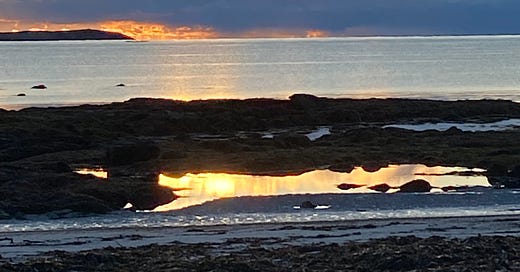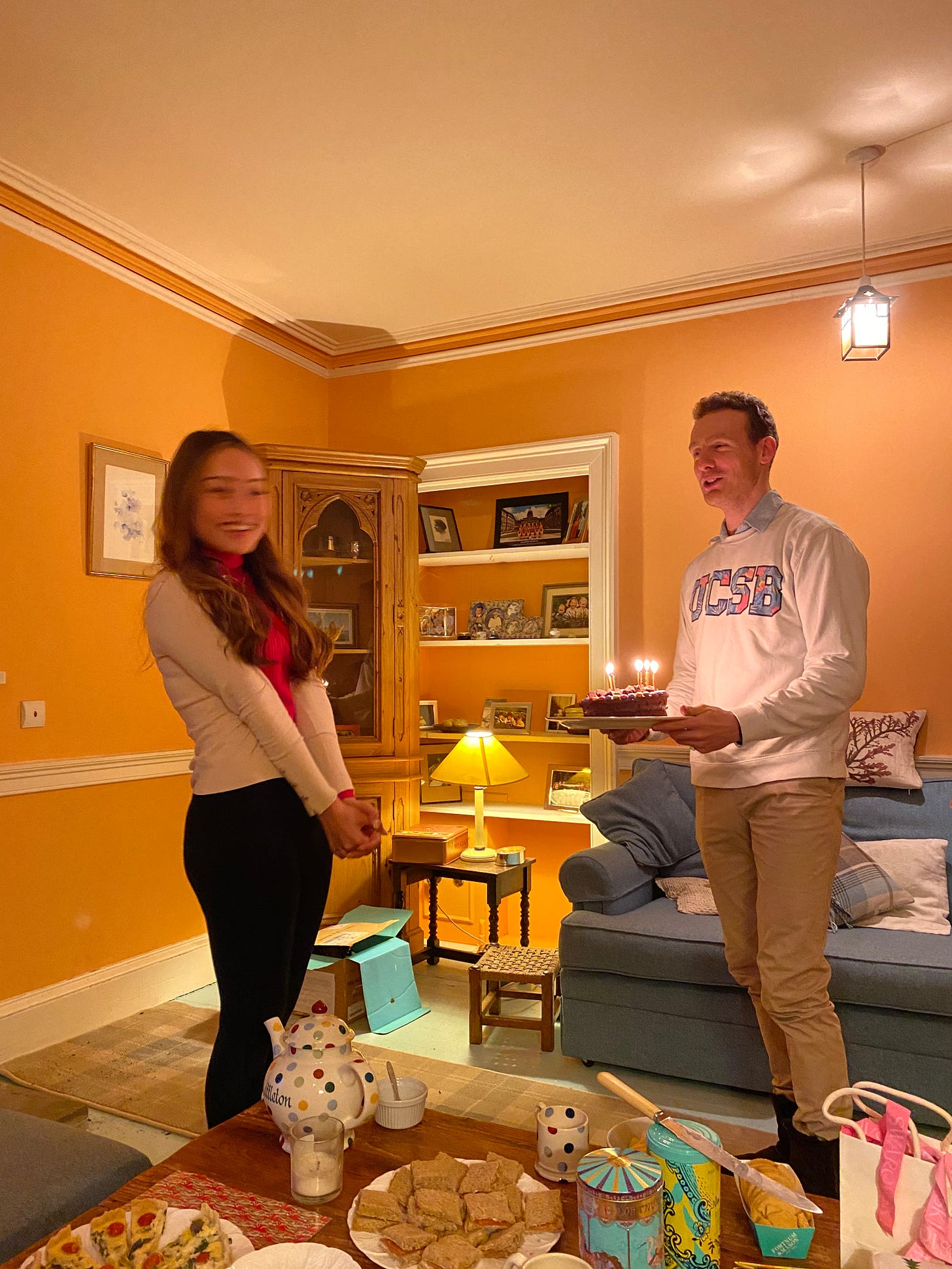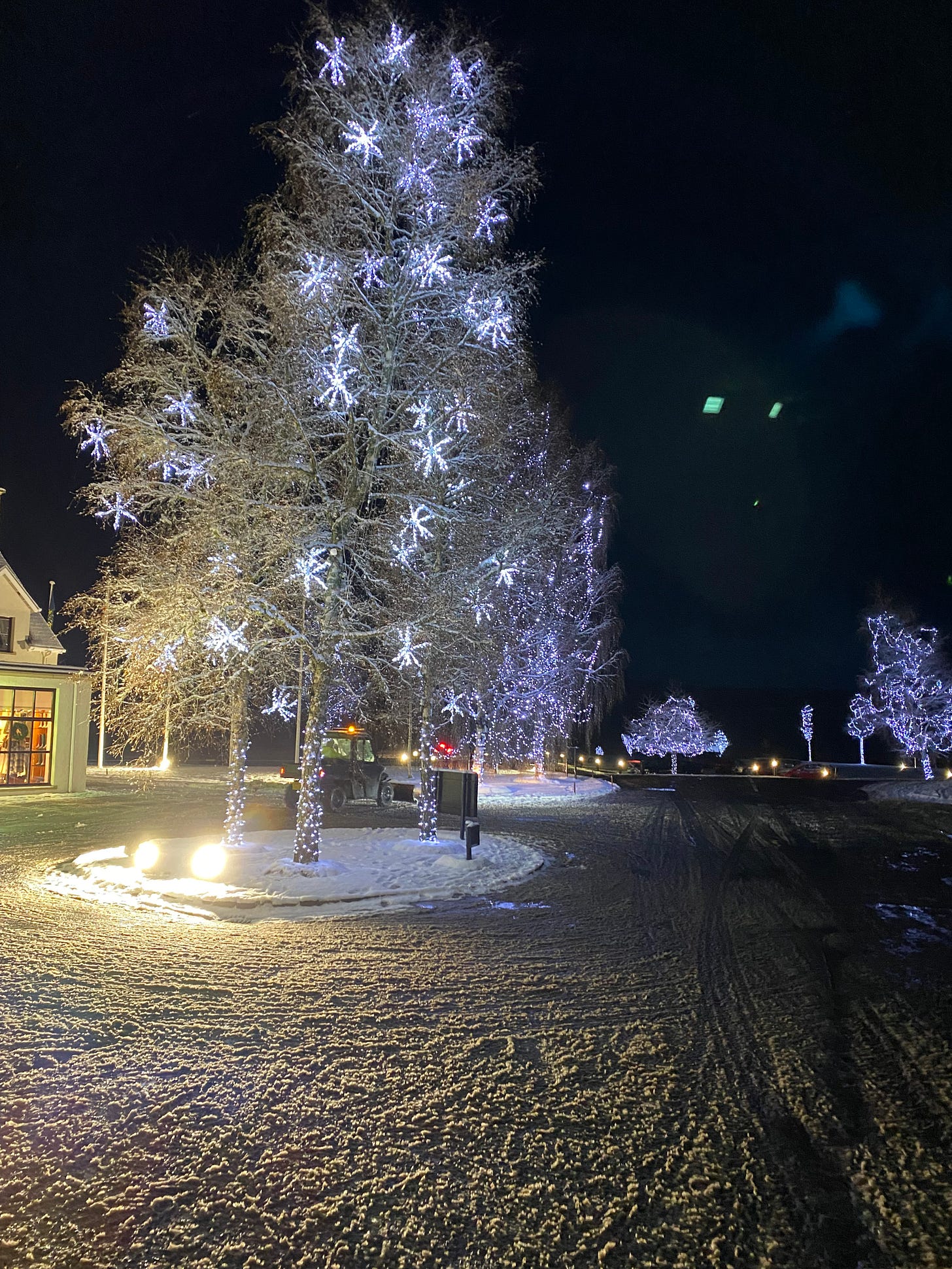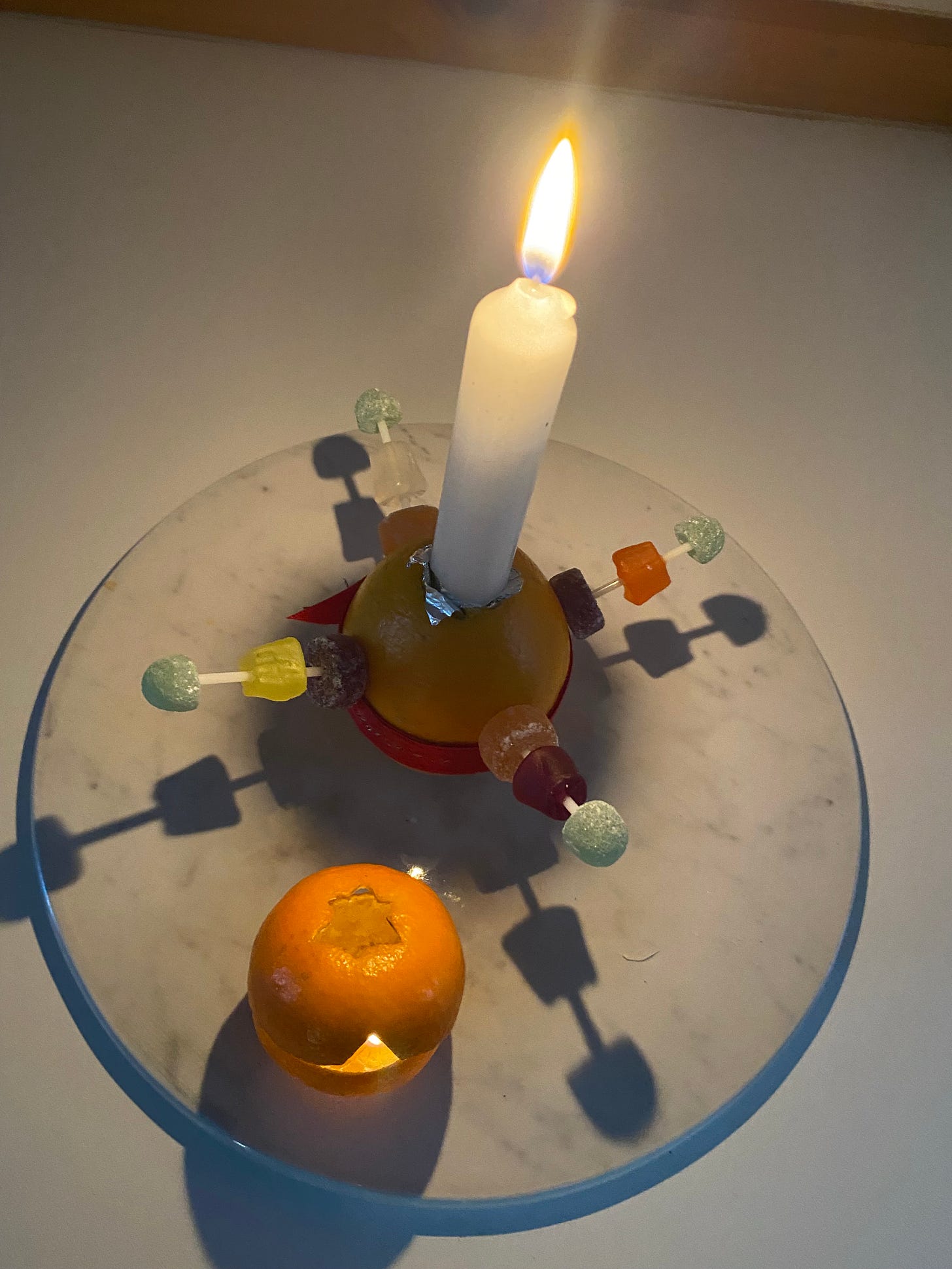Feast days in the Christian Year are observed in different ways by the various branches of Christianity: Orthodox, Roman Catholicism and Protestantism. Within each branch there are breakaway non-denominational and evangelical twigs that celebrate only the major feast days.
13th December, the shortest day in the old Julian Calendar is The Feast of St Lucia. St Lucia is associated with the patronage of light (taken from the Latin: Lux, light, or lucus, daylight). It is also known as St Lucy’s day. St. Lucia was an Italian, martyred for her faith in A.D. 304. The patron saint of the blind and dressmakers, St Lucia is reported to have given food to persecuted Christians who were hiding in the catacombs of Rome. On St Lucia’s day, which is celebrated in Scandinavian countries, a chosen girl (usually the eldest daughter in a family) is dressed in a white dress (light) with a red sash (martyrdom) and wears a crown of evergreen and candles – the Bearer of Light. Saint Lucia shines a light of hope in an unknown future. Her crown is made from lingonberry branches; evergreens symbolise new life in the depths of winter. Scandinavian folklore says that demons, fairies and goblins roam wild on the shortest night. Amongst other baking, a snake shaped saffron bun known as a Lussekattor Lucy (light) Cat is eaten to ward off evil. The chosen Lucia with a lighted head wreath, leads a procession accompanied by handmaidens (tarnor) and star boys stjarne-gossarne, who perform in a not dissimilar way to medieval mummers (masked actors - see my Mockery substack). Treats are offered to onlookers (Gingerbread and Lucy Cats) as the procession passes.
Santa Lucia
Night walks with a heavy step
Round yard and hearth
As sun departs from earth
Shadows are brooding
There in our dark house
Walking with lit candles
Santa Lucia! Santa Lucia!
The word light is used liberally in both the Old and New Testaments. Its meaning is both physical and spiritual :
Ps 119:105 Your word is a lamp to my feet and a light to my path. (KJV)
John 1:6-9 If we say that we have fellowship with him, and walk in darkness, we lie, and do not the truth: but if we walk in the light, as he is in the light, we have fellowship one with another, and the blood of Jesus Christ his Son cleanseth us from all sin.(KJV)
John8:12 (in reference to Jesus) Then spake Jesus again unto them, saying, I am the light of the world: he that followeth me shall not walk in darkness, but shall have the light of life(KJV)
The ritual of the Christian Calendar keeps the Christian on track with nature’s seasons and rooted in Christ.The season of Advent is one of anticipation of birth (Isaiah refers to Jesus as Emmanuel meaning God is with us) and the Second Coming of Christ.At this time of year the hours of daylight are short, but sunrises and sunsets can be stunning. In the Outer Hebrides, December days often end with warm irnbru (orange) and candy floss pink skies. Heart warming. A halo of joy around the December days at the closing of the year.
The use of candles as a Christmas tradition signifies Christ as the light of the world. Each Sunday during Advent a candle is lit on the Advent wreath. It’s progressive in that candles are relit i.e. two candles on the second Sunday in Advent, three on the third culminating in the Christ Candle on Christmas Eve – Christ as the Light of the World. Many Churches celebrate Christmas Eve with a Carol Service by Candlelight.
Tallow used in candle making is animal fat, usually mutton or pig and occasionally beef. It is a much cheaper option than beeswax which was reserved for the candles of the nobility and for use in churches. The candles were made in a mould or by dipping the wick into tallow (allowing time for it to solidify). Candles can be, and were, made from other materials beyond animal fat and beeswax. There were even feathered candles, the Stormy Petrel being one. This bird was so named because it foretells storms by walking on water (a power attributed to St Peter), as it feeds on small fish thrown up by the waves. Strong, plump petrel chicks were plucked, decapitated, dried and a tarred string (a wick) was then threaded through the chick’s oil saturated body. The chicks were used as candles during winter. The fulmar petrel possesses a large amount of oil as do the gannet and puffin which islanders on St Kilda (an isolated Outer Hebridean archipelago which was abandoned in 1930) used for food, feathers and oil. Fulmars spit oil as a defence action against predators. Disturbed nesting birds project oil violently and this oil was collected by the Islanders in a can or the dried stomach of a gannet. Coconut oil and whale oil, made from the oil of the blubber of the sperm whale was also used in candles. The finest quality of whale candles were made from the semi solid waxy substance found in the sperm whale’s head cavities - Spermaceti candles. These candles were prized for their clear, unscented light.
The Talmud forbade the use of tallow in Sabbath candles due to it being unclean. This posed a problem in Medieval Northern Europe where access to olive oil as an alternative, was difficult. Until the twelfth century some churches and synagogues lit two candles; the first made from wax to honour the Sabbath, the second from tallow (non kosher animal fat), to provide light. Hanukkah, the Jewish Festival of Lights celebrates the rededication of the second Temple in Jerusalem. It occurs on the eve of the Kislev 25 (from late November to late December) and at its heart is the nightly lighting of the menorah - candles play a central role in Hanukkah.
After chemists were able to separate and refine the naturally occurring waxy substance from petroleum; odourless paraffin wax candles became widely used. Production is a highly mechanised process. The Worshipful Company of Tallow Chandlers has its origins in craftsmen working to support the tallow candle. It still maintains strong links with the oil and edible fat industries and the energy sector.
Blowing out the candles on Birthday cakes brings a waterfall of childhood memories. At some point, with increasing years, excitement may dwindle, but the candle provides an opportunity for those who want to celebrate to continue to do so. Candles are synonymous with celebration or for some, the lighting of a candle stimulates remembrance in unification with the communion of saints.
There are many legends around the history of the candle lit Christmas Tree. Some link its origin with an eighth century missionary St. Boniface who cut down a young fir tree:‘ This little tree, a young child of the forest, shall be your holy tree, tonight.’ If the tales are to be rooted in Germany, a favourite is attributed to Martin Luther, perhaps because he used candles. After walking on a clear and starry night, Luther is said to have cut a small fir tree and covered it in tiny candles to share the Christmas message with his family. The tree symbolises Christ, the Tree of Life, The Light of the World.
Candle choice reflected (and still does) social standing; the act of lighting the candle was historically a woman’s responsibility. From cheap tallow for servants’ use to expensive beeswax burning in candelabras. Candles that didn’t require too much attention to the wick (snuffing) were more expensive. This is still true with regard to branded scented room candles; choice being limited by purchasing ability.
The tea light takes its name from warming tea – a small candle was placed in a warmer under the teapot or indeed a small tray of food. Tea lights were (and still are) useful in infusions (e.g. Friar’s Balsam) and fondues, although the Clarke Pyramid has been superseded by the microwave for warming infant food. Today, the humble tea light tends to have a more glamorous role as it floats fragrantly in bath tubs – an olfactory hit. Mood can be stimulated by soft light: a romantic candlelight dinner or relaxation in a room where the stark edge of artificial light is blurred. Candle light is an indulgence but one that need not be overly expensive. Candlelight offers a glance at simpler times; a move away from technology and perhaps the time to think or in Advent, prepare to welcome the Christ-child. Candles symbolise warmth, shelter and love.
The expression not worth the candle is recorded in Sir William Temple’s Works (1690) ‘Perhaps the play is not worth the candle. ’The phrase is also attributed to gamblers who were required to pay for candles to light gambling rooms. If the stakes were small the additional expense of a new candle was not worth the dice player’s money i.e. to light the table to watch the movements of other players. Worthless. This contrasts hugely with the use of a candle in Luke15:8
Either what woman having ten pieces of silver, if she lose one piece, doth not light a candle, and sweep the house, and seek diligently till she find it?
17th December was the original day of the Roman festival Saturnalia. At one time it extended to seven days. Augustus limited it to three and it was then increased to five days. It marked the end of agricultural activity. Houses were decorated with candles to worship the father of seasons in anticipation of the return of the sun after the winter solstice. A blaze of light. Frazer in The Golden Bough writes of Saturn as a just and kindly monarch who issued ridiculous commands. All work was to cease ‘save such as tend to sport solace and delight.’ Saturn was in short, a Lord of Misrule. However, by the light of an Advent candle we can read Paul’s words in 1Cor4:10 We are fools for Christ's sake, but ye are wise in Christ; we are weak, but ye are strong; ye are honourable, but we are despised. (KJV)
The permanent date for Christmas was possibly established by way of paganism under the Roman Empire. The feast, one of the two major cycles in the Christmas year came to Britain with St Augustine. Augustine’s Gregorian Mission converted King Ethelbert and his Kingdom to Christianity. In A.D. 598 ten thousand people were reported to have been baptized on Christmas Day. By the middle of the eighth century, Christmas, Epiphany and Easter were recognised as main feast days .Whatever the exact date of Christmas , the birth of Christ was a world changing event. Christmas was certainly well established by the time of the poet John Milton (1608-74).He writes
It was the winter wild,
While the Heaven born child
All meanly wrapt in the rude manager
The cook in me muddles Christingle with Kris Kringle (a Santa Claus stollen), indeed, there may well be a corruption of the word, but the two are unrelated. The Christingle is an orange used as a receptacle for a candle which represents Christ as the Light of the World. The Christingle Service during which the Christingle candle is lit, takes place on the last Sunday in Advent or on Christmas Eve.
· The orange represents the world – a time for unity and hope.
· The red ribbon covers the world and its colour is symbolic of the blood that Jesus shed for us
· The sticks represent the seasons: Spring, Summer, Autumn and Winter; and the corners of the world: North, South, East and West
· The sweets remind us of the gifts of God.
My children have grown up peeling Christmas citrus fruits with great care – to allow them to make lighted, scented Satsuma Candles.
Carefully cut the satsuma peel in half to remove the peel in two complete halves. Mark a star in the upper half (without the pithed root).
Using the pith as a wick add vegetable oil and light the wick.
Reassemble the satsuma
Advent is when the liturgical year has come full circle and there is anticipation of a future reign of Christ - eschatology. The Christian welcomes a new year as we anticipate the birth of Jesus – Emmanuel. God is with us.









Wonderful post as always. I can imagine the satsuma candle smell must have complemented your photos nicely!
Your post puts me in mind of the various references to candles in Dickens’ A Christmas Carol, from Scrooge’s refusal to light one as he climbs the stairs because: “Darkness is Cheap and Scrooge likes it”, to the clerk trying to “warm himself at the candle; in which effort, not being a man of a strong imagination, he failed”, to Cratchit’s wife blaming the candlelight for her weak eyes trying in vain to disguise her tears for Tiny Tim.
Light is such a basic need at this time of darkness it is no wonder that almost all cultures and religions have some festival of light at this time to brighten our seasons and amazing to think that as recently as 100 years ago arranging to acquire the fuel to bring that light was still a major task in most parts of the world. Maybe it still is.